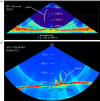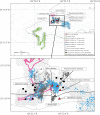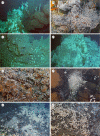Deepest and hottest hydrothermal activity in the Okinawa Trough: the Yokosuka site at Yaeyama Knoll
- PMID: 29308272
- PMCID: PMC5750039
- DOI: 10.1098/rsos.171570
Deepest and hottest hydrothermal activity in the Okinawa Trough: the Yokosuka site at Yaeyama Knoll
Abstract
Since the initial discovery of hydrothermal vents in 1977, these 'extreme' chemosynthetic systems have been a focus of interdisciplinary research. The Okinawa Trough (OT), located in the semi-enclosed East China Sea between the Eurasian continent and the Ryukyu arc, hosts more than 20 known vent sites but all within a relatively narrow depth range (600-1880 m). Depth is a significant factor in determining fluid temperature and chemistry, as well as biological composition. However, due to the narrow depth range of known sites, the actual influence of depth here has been poorly resolved. Here, the Yokosuka site (2190 m), the first OT vent exceeding 2000 m depth is reported. A highly active hydrothermal vent site centred around four active vent chimneys reaching 364°C in temperature, it is the hottest in the OT. Notable Cl depletion (130 mM) and both high H2 and CH4 concentrations (approx. 10 mM) probably result from subcritical phase separation and thermal decomposition of sedimentary organic matter. Microbiota and fauna were generally similar to other sites in the OT, although with some different characteristics. In terms of microbiota, the H2-rich vent fluids in Neuschwanstein chimney resulted in the dominance of hydrogenotrophic chemolithoautotrophs such as Thioreductor and Desulfobacterium. For fauna, the dominance of the deep-sea mussel Bathymodiolus aduloides is surprising given other nearby vent sites are usually dominated by B. platifrons and/or B. japonicus, and a sponge field in the periphery dominated by Poecilosclerida is unusual for OT vents. Our insights from the Yokosuka site implies that although the distribution of animal species may be linked to depth, the constraint is perhaps not water pressure and resulting chemical properties of the vent fluid but instead physical properties of the surrounding seawater. The potential significance of these preliminary results and prospect for future research on this unique site are discussed.
Keywords: biodiversity; chemosynthetic ecosystem; fluid chemistry; hydrothermal vent; microbial composition; sulfide deposit.
Conflict of interest statement
We have no competing interests.
Figures










References
-
- Corliss JB, et al. 1979. Submarine thermal sprirngs on the Galapagos rift. Science 203, 1073–1083. (doi:10.1126/science.203.4385.1073) - DOI - PubMed
-
- Spiess FN, et al. 1980. East pacific rise: hot springs and geophysical experiments. Science 207, 1421–1433. (doi:10.1126/science.207.4438.1421) - DOI - PubMed
-
- Beaulieu SE, Baker ET, German CR, Maffei A. 2013. An authoritative global database for active submarine hydrothermal vent fields. Geochem. Geophys. Geosyst. 14, 4892–4905. (doi:10.1002/2013GC004998) - DOI
-
- Baker ET, Resing JA, Haymon RM, Tunnicliffe V, Lavelle JW, Martinez F, Ferrini V, Walker SL, Nakamura K. 2016. How many vent fields? New estimates of vent field populations on ocean ridges from precise mapping of hydrothermal discharge locations. Earth Planet. Sci. Lett. 449, 186–196. (doi:10.1016/j.epsl.2016.05.031) - DOI
-
- Elderfield H, Schultz A. 1996. Mid-ocean ridge hydrothermal fluxes and the chemical composition of the ocean. Annu. Rev. Earth Planet Sci. 24, 191–224. (doi:10.1146/annurev.earth.24.1.191) - DOI
Associated data
LinkOut - more resources
Full Text Sources
Other Literature Sources

